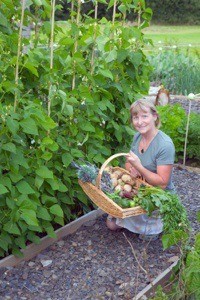
Ideally, you want to pick your vegetable crops when they at the peak of freshness. For some crops this means keeping almost a daily vigil to ensure you catch them at their peak. Here are some hints for when to harvest some common garden vegetables.
Asparagus: Harvest asparagus spears from established beds when they are 4 to 10 inches long. To prevent spears from becoming fibrous, harvest them at least every other day. Spears with loosely formed heads have passed their prime.
Beans: Frequent harvesting will keep bush and pole beans producing longer.
Beets: Harvest beets when they reach the size of a golf ball up to a tennis ball. Smaller beets will give you less overall quantity, but better quality.
Broccoli: Harvest them when the buds on the head are firm and tight (approx. 4-5 inches across). Cut the heads 5 to 10 inches down the stalk to promote an abundance of tender side shoots that can be harvested later.
Brussels Sprouts: You'll get the best flavor after a light frost. Pick individual heads as needed or harvest the entire plant (place the roots of whole plants in a pail of water to keep them fresh).
Cabbage: Cabbage tastes best after a frost or two. Harvest them when firm, glossy heads have formed (they may look small). When left too long the heads will split. If too many are maturing at once, try giving a few heads a gentle twist while still in the ground. This will break some of the roots and temporarily prevent splitting.
Carrots: Carrots can be pulled every few days as soon as they are big enough to eat. They are easier to pull out of the soil on a day when the ground is slightly moist. In cool weather they can be left in the ground for several weeks.
Cauliflower: Harvest when the heads are solid, before the curds roughen and start to separate.
Celery: Use a knife to harvest single stalks from the outside or dig up whole heads using a spade.
Corn: Check for readiness when the silks have turned brown but are not completely dry. Pull back the husk and poke a kernel with your thumbnail. If the liquid is milky, pick the corn. If clear liquid comes out, it's not ready. If no liquid comes out, it's past its prime.
Cucumbers: Clip them from the vine as soon as the cucumbers are large enough. Harvest pickling types daily to keep the vines productive.
Eggplants: Pick when the fruits are big enough to eat. The skin should be glossy not dull. Pick often to keep plants productive.
Lettuce: Harvest leaves early in the morning to preserve crispness. Once lettuce start to bolt, it gets bitter. Shear rows or patches of leaf lettuce with scissors. They will resprout for additional harvests.
Onion: Pull green onions as needed. If storing bulb onions, allow the bulbs to mature before harvesting. When tops start to yellow, the bulbs are maturing. This process can be sped up by bending the tops over.
Peas: Pick garden peas when the pods are plump and the peas are just touching. Wait too long and they'll get starchy. Snow peas should be harvested when they're 3 to 4 inches long, but before the seeds start to swell. Harvest dry peas when the pods are brown and dry and the seeds rattle when you shake them.
Peppers: For maximum flavor, harvest peppers after they have completely changed to their mature color.
Potatoes: You can start harvesting potatoes shortly after they flower. At this early stage, they are called "new" potatoes. Once the foliage starts to turn brown they have reached their full size.
Pumpkins: Wait to harvest pumpkins until the vines have died back. (usually 90 - 130 days after planting). If you can't break or dent the skin easily with your thumbnail, the pumpkin is ready.
Rhubarb: Don't harvest the first year after planting. The second year after planting, harvest for two weeks. The third year after planting, harvest for one or two months. From then on, harvest as often as you like.
Squash: Summer squash are best if harvested while they are still small - about 3 to 4 inches across or 4 to 6 inches long. Winter squash should be allowed to ripen fully on the vine before picking. It's ready when you can't pierce the skin with your fingernail.
Sweet Potatoes: Start checking sweet potatoes about 70 days after planting and harvest them when they reach the desired size. The crop should be fully harvested after the first frost or when the vines turn yellow.
Tomatoes: Pick them when they develop their mature color. Check them daily because they can pass their prime quickly.
Turnips: Pick them for their greens anytime they are large enough to use. The roots taste best when they are 1 to 3 inches in diameter.

About The Author: Ellen Brown is an environmental writer and photographer and the owner of Sustainable Media, an environmental media company that specializes in helping businesses and organizations promote eco-friendly products and services.
Add your voice! Click below to comment. ThriftyFun is powered by your wisdom!
Add your voice! Click below to comment. ThriftyFun is powered by your wisdom!